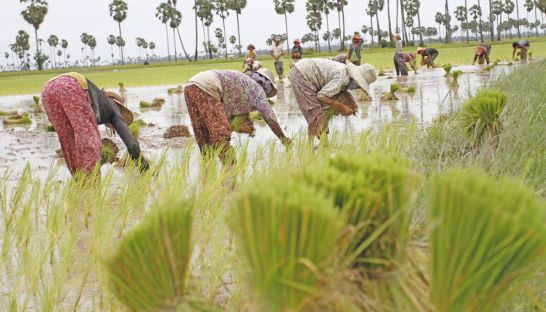Productivity rests on rainfall
Productivity rests on rainfall
Banking on more favourable weather conditions this year, the Ministry of Agriculture is predicting a 3 per cent increase in rice production for the 2015-2016 season, after a prolonged drought period saw a downturn in last season’s harvest.

Rice productivity last year fell to 3.07 tonnes per hectare, down 2.67 per cent, from an average of 3.1 tonnes per hectare in 2013. The total harvest last season was 9.32 million tonnes of paddy, down 0.7 per cent from the 9.38 million tonnes in 2013, according to annual report from the ministry.
A yearly dry spell, that typically lasts for just a few weeks of July, last year stretched well into August causing delays and damage to many crops.
The agriculture report showed that close to 200,000 hectares were affected by the drought, while about 20,300 hectares of paddy rice has been completely damaged, the highest record of rice destruction since 2010, the report said.
Pich Romnea, deputy director of the ministry’s Paddy Rice Production Department, said yesterday that rice yields are expected to improve this year, in anticipation of more rain.
“The plan is to increase rice productivity this season by 2 per cent while the total paddy rice production is expected to go up by 3 per cent,” he said.
“Our goal is to increase rice productivity from the current average of 3 tonnes to 4.5 tonnes per hectare. It can be achieved when there is enough water for the rice field, so that [farmers] can farm two to three times per season,” he said.
Cambodia’s main rice production season, known as the rainy season, typically begins in June and can last up until February. The dry season runs between November and April.
Romnea said the government is improving irrigation systems and has been educating farmers on proper seed selection and farming techniques to help respond to the challenges of climate change.
Existing irrigation canals in Cambodia cover about 51 per cent of the total 2.5 million hectares of rice cultivation area, according to Chan Yutha, spokesperson and head of cabinet of the Ministry of Water Resources and Metrology.
“Since available resources and budget are very limited, we can only focus on restoring bigger water channels to make sure we can store water from the rainy season to use in dry season,” he said.
“The government is aware that extension water channels from the bigger channels are important, but since we have limited budget and resources, we will first work on what is considered as priority: storing water,” he added
The ministry was focusing its efforts on several “megaprojects” including the restoration of Vai Ko river in Svay Rieng province which is expected to make water accessible to 330,000 hectares of cultivation area in Kampong Cham, Prey Veng and Savy Rieng provinces. Another project, he added, was the creation of water reservoirs by the Cardamom and Dangrek Mountain ranges.
Independent economic analyst Srey Chanthy, said yesterday that Cambodia has the potential to significantly boost levels of productivity, which is needed for its export industry to become competitive.
“Vietnam can achieve 6 tonnes per hectare, Cambodia can make 5 tonnes if there is enough water, good quality seed and [the right] farming techniques,” he said.
Chanthy said focusing on bigger canals would help store water for use during dry season, but smaller water canals were needed to reduce costs.
“Without smaller canals accessing their rice fields, farmers will need to pump the water into the rice field from the bigger canals, and that makes production costs higher because of gasoline,” he said.
“Even though, they can produce 5 tonnes per hectare, they will not gain much margins from that, as the cost of production has not been reduced,” he said.













